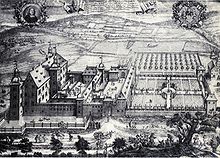Adolfsburg Castle
The Adolfsburg Castle , also spelled Adolphsburg , is a moated castle in the Hundem Valley at the entrance to Oberhundem , a district of the municipality of Kirchhundem in the Olpe district in North Rhine-Westphalia .
history
Adolfsburg Castle takes its name back to the builder Johann Adolf von Fürstenberg , who probably had it built in the 1670s according to plans by Ambrosius von Oelde . It is a baroque moated castle that was primarily intended for the builder as a place to relax and retire. Johann Adolf von Fürstenberg, a member of the family who had been wealthy in the offices of Bilstein and Waldenburg since the 16th century , belonged to the clergy. He was a member of the cathedral chapter of Münster as well as canon and provost of the Holy Cross in Hildesheim . It is believed that he entrusted the Capuchin brother and architect Ambrosius von Oelde with the planning of the Adolfsburg.
Two chimneys in the knight's hall and an alabaster bust by Johann Adolf von Fürstenberg are works by the sculptor Johann Mauritz Gröninger . Presumably the earlier baroque furnishings of the knight's hall also go back to designs by Gröninger.
The construction was made possible by the purchase of various farms in Oberhundem by Johann Adolf from the property of the married couple Wilhelm Heinrich von Bruch and Johanna Maria Stael von Holstein, including the so-called Waltmanns Hof or Brucher Hof. With a diploma dated February 20, 1676, Emperor Leopold I elevated the castle to a noble mansion. Johann Adolf von Fürstenberg conducted intensive land acquisitions in and around Oberhund, thus rounding off his property there.
The outer bailey was built around 1681. After Johann Adolf, who had his permanent residence in Schloss Adolfsburg from 1679 until his death in 1704, two more generations of the von Fürstenberg family lived there , namely Clemens Lothar (1725–1791) with his Family from 1758 until the end of the 1780s and Friedrich Leopold, born there in 1766, from 1819 until his death in 1835.
Later generations of the von Fürstenberg family took their headquarters in Herdringen Castle near Arnsberg . Therefore the Adolfsburg only fulfilled the function of a hunting lodge for them . Parts of the outer bailey were destroyed by fire in 1901. In order to restore the building to continuous use, it was rented to the missionaries of the Holy Family in 1919 , who set up their first missionary school on German soil there. In 1940 the school was closed by the National Socialists . During the Second World War evacuees were housed in the Adolfsburg. In addition, parts of the collection of the Düsseldorf City Museum were deposited here for security reasons . It was not until 1946 that the mission school was able to resume operations, initially with ten students. Since then, the Order and the school in the 1956 at Altenhundem built Queen monastery and school Maria had moved, castle Adolf Castle stood empty for several decades and was threatened by decay.
After years of intensive efforts to preserve the building, it was possible in the mid-1980s to find an investor who was willing to restore the castle and use it appropriately. On March 7, 1985, the Adolfsburg was registered as an architectural monument in the monuments list of the Kirchhundem community. In the meantime, the castle has been divided into individual residential units.
description
The castle is a baroque mansion with a front and main castle. The main house is two-story with two protruding pavilion towers on the west side and a square stair tower with a baroque portal on the courtyard side. There is a two-storey chapel room in the northern service wing . The park belonging to the castle was built in 1713 and is still partially preserved. An indoor swimming pool was built on part of the park in 1970 .
location
The castle is located near the western entrance to the town. The Hundem , which flows into the Lenne, flows past south of the castle .
literature
- Günther Becker, Martin Vormberg: Kirchhundem. History of the office and the community . Kirchhundem community, Kirchhundem 1994, ISBN 3-923483-15-5 .
- Adolf Färber: Adolfsburg and Rüsper Wald . Olpe 1941.
- Theo Hundt: The Adolfsburg, a moated castle . In: Voices from the Olpe district . 69th episode, No. 4, 1967, pp. 235-236.
- Aloys Klein (Hrsg.): Contributions to history. Parish and community of Oberhundem . Self-published, Oberhundem 1972.
- Albert Ludorff : The architectural and art monuments of the district of Olpe (= The architectural and art monuments of Westphalia . Volume 14). Schöningh, Paderborn / Münster i. W. 1903, pp. 82-83, plates 36-38 ( online ).
- Margarete Lippe: Unknown work by Johann Mauritz Gröninger on the Adolfsburg and Herdringen Castle . In: Westphalia. History, art and folklore books . 21st year, 1936, issue 5, pp. 207ff.
- Georg Dehio: Handbook of the German art monuments: Dehio handbook, North Rhine-Westphalia II: Westphalia. Published in cooperation with LWL-Denkmalpflege u. a .; under the scientific direction of Ursula Quednau. Paderborn 2001, article: Kriechendem, Adolfsburg
- Martin Vormberg: The hunting districts of Schloss Adolfsburg. Historical views of the town and landscape elements in the South Sauerland around 1743/44 . Kirchhundem 2013.
- The German castles and palaces in color, Frankfurt am Main 1987
- Kracht, August: Castles and palaces in the Sauerland, Siegerland and on the Ruhr, Munich 1983
Web links
Individual evidence
- ↑ a b c d Moated Apolphsburg Castle. alleburgen.de, accessed on November 26, 2019 .
Coordinates: 51 ° 5 ′ 7 ″ N , 8 ° 10 ′ 11 ″ E



